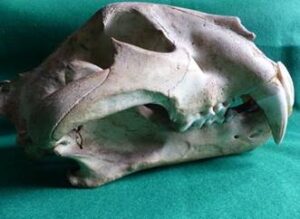Panthera tigris

Figure 5 – Tiger [Bhavik Thaker. Tiger roar. [online image]. Available from: https://wordpress.org/openverse/image/505afbb1-7022-4f5c-8eca-6d4fe14b31ae. (Accessed 07 July 2022)].
Dental Formula: I 3/3 𝐶1/1 𝑃3/2 𝑀1/1
This skull (see below) belongs to one of the greatest terrestrial predators – Panthera tigris, more commonly known as the tiger. Tigers are carnivores, and like most carnivores they are predators. Because of this they need to have very sharp canines in order to keep hold of prey whilst tearing flesh off. Additionally, their incisors are a lot sharper than in other mammals to help cut through certain muscles and tissues. The canines belonging to the tiger are particularly long – growing up to 3 inches – and they are also slightly curved to make it even harder for any prey to escape from its powerful jaws (see Figure 6). Not only are its canines sharp, but the tiger’s incisors have also been adapted to be extremely sharp – they’re so sharp that they can cut through the hide of a buffalo. Although they have a low number of molars, the ones they do have are sharper and are used for slicing instead of chewing, as their food is swallowed in chunks). You’ll also notice from Figure 7 that the Tiger’s eye sockets are facing forwards and are rather large. This is common in most predators because this allows their vision from both eyes to overlap, giving them binocular vision and very good depth perception. This comes in handy when both searching for prey and avoiding obstacles while catching it.


Figure 6 – Tiger skull Open Jaw (left). Close Up of Closed Mouth (right)

Figure 7 Side View of our Tiger Skull [All photographed by James D’Arcy (2018)]